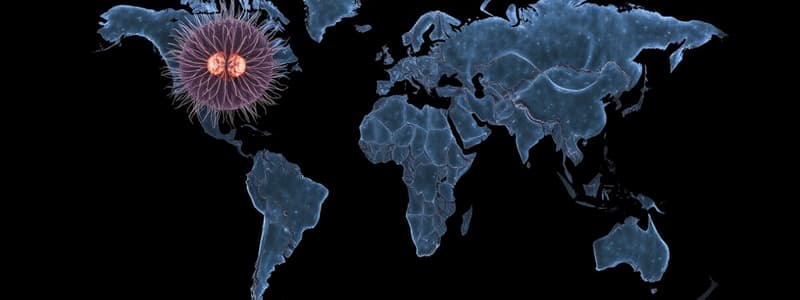Podcast
Questions and Answers
Which of the following are pieces of evidence that support common ancestry for all eukaryotes? (Select all that apply)
Which of the following are pieces of evidence that support common ancestry for all eukaryotes? (Select all that apply)
- Membrane bound organelles (correct)
- Circular chromosomes
- Linear chromosomes (correct)
- Genes that contain introns (correct)
What structural similarities exist between chloroplasts and mitochondria? (Select all that apply)
What structural similarities exist between chloroplasts and mitochondria? (Select all that apply)
- Endosymbiotic theory (correct)
- Circular genomes (correct)
- Ribosomes (correct)
- Single-membrane
Where are linear chromosomes found?
Where are linear chromosomes found?
All organisms
Where are chromosomes found in eukaryotes?
Where are chromosomes found in eukaryotes?
Describe chromosome structure.
Describe chromosome structure.
Are the genomes large or small in eukaryotes?
Are the genomes large or small in eukaryotes?
What are the traits of chromosomes in prokaryotic organisms?
What are the traits of chromosomes in prokaryotic organisms?
What are introns?
What are introns?
When are introns removed?
When are introns removed?
Flashcards are hidden until you start studying
Study Notes
Evidence for Common Ancestry of Eukaryotes
- Common ancestry for all eukaryotes is supported by membrane-bound organelles, linear chromosomes, and the presence of introns in genes.
Structural Similarities: Chloroplasts and Mitochondria
- Both chloroplasts and mitochondria exhibit a double-membrane structure, contain circular genomes, and have their own ribosomes, supporting the endosymbiotic theory.
Chromosome Locations
- Linear chromosomes are found in all organisms, demonstrating a universal characteristic among life forms.
- In eukaryotic organisms, chromosomes are located within the nucleus, in contrast to prokaryotes.
Chromosome Structure and Characteristics
- Chromosomes are composed of tightly coiled DNA associated with histone proteins, with telomeres at their ends for protection and stability.
- Eukaryotic genomes are typically large, containing extensive genetic information.
Chromosomes in Prokaryotic Organisms
- Prokaryotic organisms possess a single circular chromosome situated in the cytoplasm, characterized by smaller genomes compared to eukaryotes.
Role of Introns
- Introns are non-coding regions commonly found in eukaryotic genes, playing a role in gene regulation.
- During RNA processing, introns are removed before protein synthesis, ensuring that only coding sequences are translated into proteins.
Studying That Suits You
Use AI to generate personalized quizzes and flashcards to suit your learning preferences.




